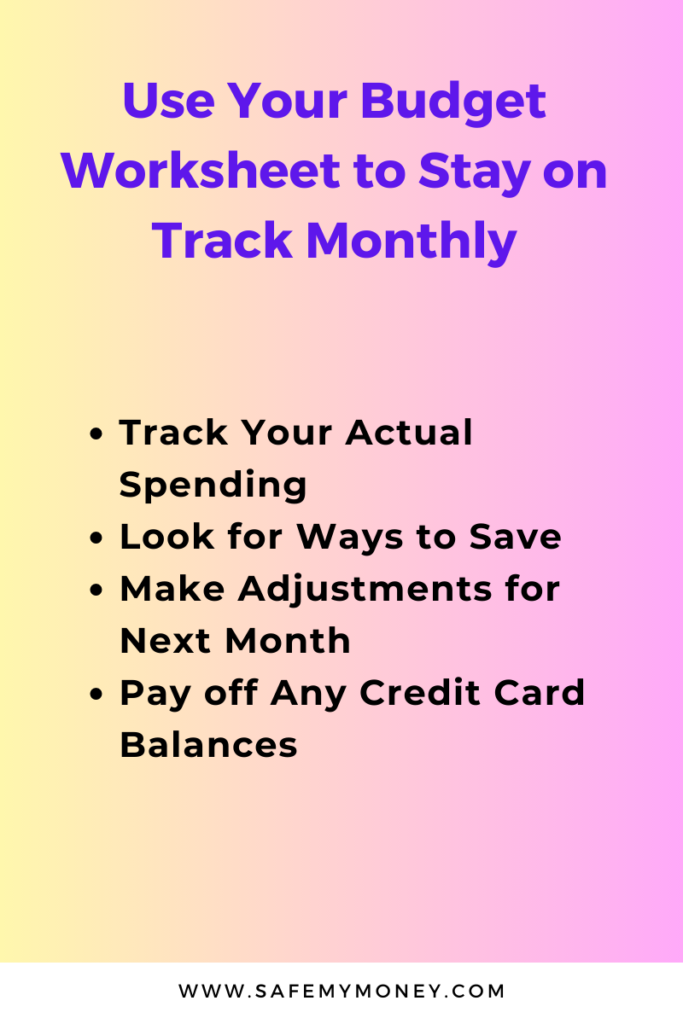Hey you, it’s time to get your finances in order. Stop living paycheck to paycheck and take control of your money once and for all. How? By creating a budget worksheet to manage your income and expenses on a monthly basis. Even if budgets make you want to break out in hives, stick with us. This simple process will transform how you think about your money and give you a clear view of where it’s all going each month. You’ll gain insight into your spending habits, find expenses you can reduce or eliminate, and free up more of your hard-earned cash to put towards the things that really matter to you. So grab your bank statements, bills, and a cup of coffee, and let’s get started building your first monthly budget worksheet. By the end of this, you’ll have a custom budget that works for your needs and the financial freedom you’ve been longing for.
How to Set Up Your Budget Worksheet
Setting up your budget worksheet is the first step to getting your finances in order. Here are the basics to get you started:
The first thing you’ll want to do is list your income sources, like your paycheck, side hustle, or other earnings. Then, add up the total to determine your monthly income.
Next, list all of your monthly expenses. This includes essentials like rent, utilities, loan payments, insurance, groceries, gas, and subscriptions. Also add discretionary items like dining out, entertainment, and hobbies. Calculate the total for your monthly expenses.
Now, compare your income and expenses. If your expenses exceed your income, you’ll need to make some cuts to balance your budget. Look for expenses you can reduce or eliminate. Every little bit helps!
Once your income and expenses are balanced, you can allocate the remaining amount to your savings goals like an emergency fund, vacation, or down payment on a house. Automate transfers to move money into your savings each month.
Review and revise your budget worksheet regularly. Make adjustments as needed to account for changes in income, expenses, or savings goals. Sticking to your budget and making mindful spending choices will help ensure your financial success each and every month.
With some time and practice, creating and maintaining a budget worksheet can become second nature. Stay committed and you’ll be on your way to mastering your money in no time!
Determine Your Monthly Income
To create your budget worksheet, you first need to determine how much money is coming in each month. This is your monthly income.
Log in to your bank accounts and any other income streams you may have, like investment accounts, freelancing payments, etc. Add up all the money that gets deposited into your accounts each month. This is your total monthly income.
Some of you may have income that varies from month to month, like commission or freelance work. In these cases, calculate your income based on an average of the past 3-6 months. This will give you a good estimate of what you can expect each month going forward.
If your income changes frequently, revisit your budget often and make adjustments as needed. It’s a good idea to overestimate your income slightly to avoid overspending. Any extra money left over can go straight to your savings!
Once you’ve determined your monthly income, list each income source and the amount. This overview will be the starting point for your budget worksheet. With your income in hand, you can then allocate how much to spend in essential expense categories like:
- Housing (rent/mortgage, utilities, insurance)
- Transportation (car payment, gas, transit pass)
- Food (groceries, dining out)
- Debt payments (loans, credit cards)
- Savings (emergency fund, other goals)
Stick to your budget by monitoring your income and expenses closely each month. Make adjustments as needed and look for ways to cut excess spending. Creating and maintaining a budget worksheet will help ensure you’re making the most of the money you earn!
Track Your Monthly Expenses
To get a handle on your monthly budget, you need to track your actual spending. The only way to really understand your cash flow is by keeping records of all the money going in and out each month.
Review Your Bank and Credit Card Statements
Go through your statements line by line and categorize each transaction. Some major categories include:
- Housing: Mortgage/rent, utilities, insurance, property taxes
- Transportation: Car payments, gas, public transit, rideshares
- Debt Payments: Student loans, personal loans, credit cards
- Food: Groceries, dining out, coffee, snacks
- Insurance: Health, life, auto, home
- Entertainment: Streaming services, hobbies, gym membership
Once everything is categorized, add up your total monthly spending in each category. This process can be tedious, but it provides valuable insight into your spending habits and expenses.
Compare to Your Budget
How do your actual expenses compare to the budget you set? Are you overspending in any areas? Look for expenses that seem higher than expected and consider ways to cut costs, like eating out less or reducing utility usage. On the other hand, if you find extra money left over in your budget at the end of the month, decide if you want to pay off any additional debt or add the surplus to your savings.
Make Adjustments
Use what you’ve learned from reviewing your statements to make any necessary adjustments to your budget for next month. Reduce limits in overspent categories or allocate more money to priorities. Having an accurate and balanced budget based on your real monthly spending and income will help ensure your financial success going forward. Make reviewing your statements and reconciling with your budget a habit, and your money management skills will grow stronger each month.
Set Limits for Discretionary Spending
Now it’s time to determine how much you can spend on non-essential items each month. Setting limits for discretionary spending is key to staying within budget. Discretionary spending includes things like dining out, entertainment, and hobbies.
Determine your discretionary income
First, calculate your discretionary income by subtracting your fixed expenses from your net monthly income. The amount left over is what you have to spend on discretionary items. Be realistic in your calculations. It’s better to underestimate your discretionary income. You can always make adjustments next month.
Set limits for each discretionary category
Break down your discretionary income into separate buckets for things like:
- Dining out: Limit this to $200-$500 per month for a single person or $400-$800 for a family. Pack lunches and cook more dinners at home.
- Entertainment: Allot $50-$200 per month for streaming services, movie tickets, sports, etc. Look for budget-friendly entertainment options in your area.
- Hobbies and personal items: Designate $50-$200 per month for hobbies, haircuts, gym memberships, and clothing. Buy less expensive alternatives or look for discounts and coupons.
-Miscellaneous: Leave some room in your budget for unexpected expenses. Set aside $50-$200 per month as a slush fund. Only spend from this fund on true miscellaneous items.
Track your spending
Once you’ve set limits, track your discretionary spending for each category. Use a budgeting app or simply record all purchases in a notebook or spreadsheet. Staying within the limits you set is key to mastering your monthly budget. If you go over in one category, pull back in another to balance it out. Make adjustments as needed for next month.
Discretionary spending limits give you flexibility while still keeping you accountable. Follow these tips and you’ll gain control of your spending in no time!

Use Your Budget Worksheet to Stay on Track Monthly
Now that you have your budget worksheet set up, it’s time to put it to use each month. Following these steps will help keep you on track with your spending and savings goals.
Track Your Actual Spending
As the month goes on, record each transaction on your budget worksheet as you spend money. Round up to the nearest dollar and note the date, description of the purchase, and amount for each item. Compare your actual spending in each budget category to the budgeted amount. Are you over or under budget? Make adjustments as needed to get back on track.
Look for Ways to Save
If you find you’re over budget in certain discretionary categories like dining out or entertainment, look for expenses you can reduce or eliminate to make up the difference. Maybe you can cut back on the number of times you eat out each week or choose free hobbies over paid events. Every dollar you can shift from overbudget to underbudget categories helps.
Make Adjustments for Next Month
At the end of each month, calculate your total income and expenses. If you ended the month with a surplus, decide if you want to allocate more to your savings goals or discretionary spending next month. If you overspent your budget, determine where you need to make cuts to balance your budget again. You may need to adjust budgeted amounts in certain categories to more accurately reflect your actual spending needs and habits.
Pay off Any Credit Card Balances
One of the biggest budget busters is credit card interest charges each month. Always pay at least the minimum amount due on time to avoid penalties and late fees. If possible, pay the full balance to avoid paying any interest charges. Make paying off high-interest debts like credit cards a top priority in your budget.
Sticking to your budget each month does take effort and discipline. But by tracking your spending, making adjustments as needed, and paying off debt, you can master your money management skills over time. Stay committed and consistent with using your budget worksheet, and you’ll be achieving your financial goals in no time!
Conclusion
You now have all the tools you need to master your money and create a monthly budget worksheet tailored to your needs. Stop worrying so much about your finances and take control of your budget. Even if budgets have stressed you out in the past, starting simply with a monthly worksheet can make the process feel more achievable. Give yourself time to adjust to new spending habits and be kind to yourself along the way. Small changes lead to big rewards. Before you know it, you’ll be balancing your budget each month with confidence and paying off debt faster than ever. Take a deep breath and get started – your financial freedom awaits! With the right mindset and these helpful tips, you’ve got this. Now go make that budget worksheet your own!




